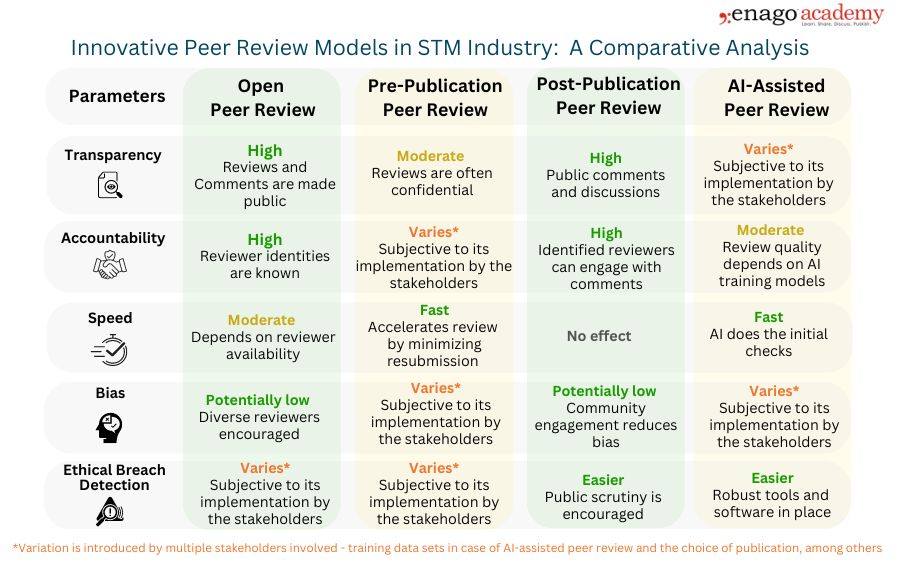Peer Review Reimagined: Innovative strategies for enhancing research quality

Peer review has been the gatekeeper of research for decades. However, this crucial process faces a numerous issues including, but not limited to, bias, lack of transparency and accountability, oversight of ethical concerns in a manuscript, and extreme delays. Moreover, reviewers are often overburdened with their academic and research responsibilities in addition to their review duties. Therefore, there is a growing need to adopt innovative peer review models that seamlessly enhance the efficiency of the process and keep pace with the growing volume of research output.
Innovative Models in Peer-Review
Open Peer Review Model
Contrary to the traditional single-blind and double-blind peer review models that advocate anonymity, open peer-review model promotes Open Science by making the reviewer’s identity publicly available. Various journals in life sciences, including Nature Communications, EMBO, Royal Society Open Science, eLife, and the PLOS journals have implemented this model.
In the open peer review model, the review reports are published alongside the article, enabling documentation of reviewer comments and the authors’ responses. As a result, this approach improves transparency and review quality, promotes accountability, and minimizes potential biases.
Pre-publication Peer Review Model
Pre-publication peer review model leverages the expertise of the research community to review and share constructive criticism on a manuscript even before it is submitted to journals. This model allows authors to address the gaps or oversights identified by contemporaries in their field before submitting their manuscript to a journal for publication. Therefore, this helps in avoiding multiple rounds of revisions and resubmissions. Furthermore, it facilitates rapid dissemination of research, increases visibility, fosters community feedback, and contributes to the principles of open science.
 Preprints is as another example of pre-publication peer review model. The first preprint server, arXiv.org, launched in 1991, gained significant traction particularly during the pandemic, with the introduction of medRxiv in 2019. This highlights the timely need for quicker and transparent methods of sharing crucial research findings within the community.
Preprints is as another example of pre-publication peer review model. The first preprint server, arXiv.org, launched in 1991, gained significant traction particularly during the pandemic, with the introduction of medRxiv in 2019. This highlights the timely need for quicker and transparent methods of sharing crucial research findings within the community.
Post-publication Peer Review Model
Scrutiny of research articles doesn’t stop once they’re published; in fact, it intensifies in the months that follow! While post-publication peer review (PPPR) has existed in multiple journals in the form letters and commentaries, a modern version of this model enables quicker and more dynamic discussions within the scientific community.
Platforms like Retraction Watch, ResearchGate, PubPeer, and social media (including X and LinkedIn) have become popular in promoting post-publication peer review, allowing researchers to engage in real-time dialogue. This model serves as a quality checkpoint to identify ethical issues such as data manipulation, statistical errors, and fundamental flaws that might otherwise go unnoticed. Detecting these issues is crucial as this allows the publication community to prevent the dissemination of false claims by retracting such articles. Over 10,000 papers got retracted last year and PPPR plays a central role in this by upholding the integrity of the publication industry.
AI-assisted Peer Review
The automated peer review model, also known as the AI-assisted peer review model, aims at reducing the reviewers’ burden and fatigue by screening the manuscript for initial checks and detecting common flaws in manuscripts. This enables reviewers to reduce their time on the preliminary checks and focus on the scientific underpinnings of the study for a more thorough and critical evaluation.
A preprint reported that the use of AI in the peer-review process can improve the review quality and streamline the workload for reviewers, ultimately boosting the speed and review efficiency.
Tools like Enago Read, has been developed and tested for their performance over the last few years. With proper human oversight, these tools promise to lead the next generation of the peer-review process.

In conclusion, publication industry, like most industries, is constantly evolving to match the modern day’s demand. This necessitates the need for innovative peer-review models that address the fundamental shortcomings posed by the traditional models. Various promising models aimed at fine-tuning the process of peer-review have been set in motion and are currently being implemented by the scientific community to uphold the cornerstone of publication industry – the peer review system. These models not only address the challenges posed by the existing system but offer innovative solutions that enhance the overall experience of all the stakeholders involved.









